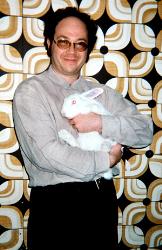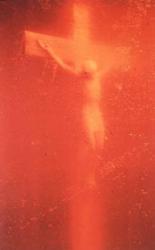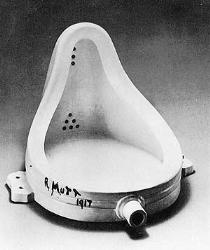
Neofiles, Vol.1 Num.12, February 2005
Transgenic Bunny Rabbit of the Universal Mind
Edited By R.U. Sirius
Start the universe with a few rules. Watch it iterate and accumulate complexity over billions of years. Add in somenanotechnology, robotics, and super-chemistry. Now, take the transgenic bunny rabbit and put it in Professor Schrödinger’s box. Wait several decades … stirring frequently. If things work out, you will have a perfectly divine singularity … to serve up to family and guests. If not, you will have an entertaining read, to be savored until we issue again.
Is A Trans Bunny Art?
Eduardo Kac In Conversation with R.U. Sirius
In 1999, Eduardo Kac, an internationallyrecognized artist who was best known for his interactive net installations,commissioned a French biotech lab to create a �transgenic bunny.�
 |
| Kac and friend� |
In case you�re not getting it, let me emphasize this: the artistEduardo Kac created a living creature, a biologically-altered bunny rabbit,as an element of an art project. For Kac however, the work didn�t endafter he had the bioluminescent creature available to display. For Kac,the project includes the discourse the bunny provokes, the events thatare triggered, and his feelings of relationship toward the bunny as a livingthing.
In the early '90s, Kac�s visionary combination of robotics and networkingexplored the fluidity of the post-digital world. Kac�s work has been exhibitedinternationally at venues such as Ronald Feldman Fine Arts, New York; OKContemporary Art Center, Linz, Austria; InterCommunication Center (ICC),Tokyo; Seoul Museum of Art, Korea. His work is part of the permanent collectionof the Museum of Modern Art in New York, and the Museum of Modern Art inRio de Janeiro, among others.
 |
| �who glows in the dark. |
Kac's writings on art, which have appeared in several books and periodicalsin many countries, have been collected in two volumes: Telepresenceand Bio Art: Networking Humans, Rabbits and Robots and Luz& Letra. Books about Kac's work include: TheEighth Day: The Transgenic Art of Eduardo Kac, Sheilah Brittonand Dan Collins, eds.
I interviewed him via email.
NEOFILES: You've become widelyknown for creating a bioluminescent bunny rabbit named Alba, but you'vebeen doing various technologically-oriented artworks for some time. Isthere an overall project that fits the glowing bunny together with, say,telepresence experiments etc.
EDUARDO KAC: The key issue I havebeen addressing in my work for about 20 years is communication. My workinvestigates the question of communication not as the transmission of informationfrom one point to another, but as a vital force. My work explores communicationas a shared space in which meaning can be negotiated. In my work I createsocial spheres in which dialogical interaction can emerge. Biological processesare important in art because they are at the crossroads of profound socialtransformations, underway through developments in biotechnology. Thesedevelopments have cultural consequences. Art is uniquely positioned toinvestigate the social and cultural meanings of biotechnology beyond simplisticaffirmations of determinism.
NF: Most observers, particularlythose outside the history of art, would assume that the intention of theAlba work is basically to shock, and to gain publicity from that. Thisis how people also look at "PissChrist", KarenFinley's performances, DamienHirst's pieces, ad infinitum. While that may not be the entirestory, isn't it actually a strong element? Did the knowledge that manypeople would react to this in horror excite you?
 |
| Shocking? |
EK My intention was never to shock.That would be too shallow and, frankly, unexciting to me as an artist.I'm interested in creating works that generate opportunity for new aestheticand cultural discoveries. Predictable work is not interesting, and anywork in which the exact outcome can be predicted (shock or otherwise) fallsin this category. In any case, the question remains as to why, in givencultures, certain works cause shock within certain circles. It is certainlymore a question of reception than intention.
NF: I see Alba as a gesture,in a tradition of gestures that go back at least to Duchamp'slatrine. The gesture hopefully resonates out into an audience andcreates meaning and dialogue, etc. One problem people have with gesturesis - once they accept them as art - how do they decide what gestures qualifyas art and what gestures are merely cheap tricks? A basketball in a glasscase?
EK Duchamp's urinal was a ready-made,an existing object that the artist displaced to the context of art. Thisis not my case at all. Alba is not an object; she is a subject.
 |
| Duchamp�s latrine. |
NF: Tell us a bit, if you will,about the dialogic interactions that have resulted from Alba. What havebeen some of the most interesting and surprising discussions? What haseffected you the most?
EK The discussion has been extremelybroad, from school children to scholars and everyone in between. Therehave been great discussions, with probing questions, such as the one conductedonline with questions posted to the Genologwebsite, July-September 2000. There were many debates, but twothat stand out in my mind were the one that followed my lecture at theUniversity of California, in Berkeley, and the one live on French televisionwith a priest, a scientist, and myself (broadcast on December 11, 2000).Some of the postings to the AlbaGuestbook have been inspired, be they tormented, perverse, or poetic.I have been affected by all of it. We never cross the same river twice.
NF: The creation of transgenicanimals usually takes place in the realm of science and/or business. Whenyou contextualize it as art, does something new happen to the entire field?Does any new meaning attach itself to the scientific and business worlds?
EK:
| Karen Finley performing. |
NF: Tell us about the relationshipthen with Alba? Do you relate to her differently that you would to anotherpet? Do people act differently around her?
EK: In2000 the lab censored my work. At the last minute they decidedto keep her caged. They also interrupted dialogue. Since then I have beenengaged in a long-tem campaign to obtain her release. It was said oncethat she is dead, but no evidence was offered, so most likely she is alive.Perhaps she is like Schrödinger�scat. The box [the lab] is closed and we do not know if the cat[bunny] is dead or alive. Since we do not know, the cat [bunny] is bothdead and alive, in a quantum superposition of states.
Back to Kac Web